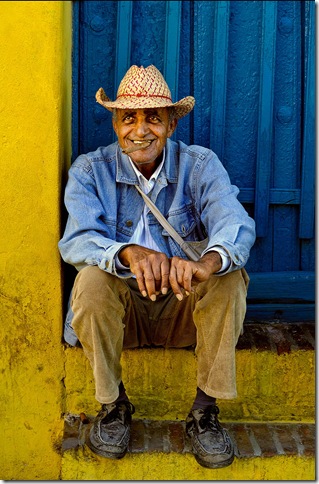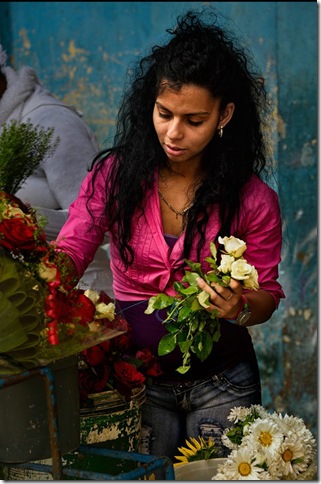It has begun. The sense of urgency in all things Cuba related. The pressure is on to taste the real cuisine, before the fast-food plague arrives, and to enjoy the beaches before a Private Property sign claims the water, the seashells, the sand…
For photographers, the rush is to capture a land before it undergoes drastic changes and becomes like everywhere else: modern and overpriced. With that in mind, Nikon digital photographer Vincent Versace, who is based in Los Angeles, headed to Cuba with a group of students from the Palm Beach Photographic Centre. The result is Cuba: Contrasting Visions.
Running through June 13, the exhibition contains more than 200 color and black-and-white photographs taken over the past year in Havana and surrounding regions, such as Trinidad and Pinar del Rio. About 80 appear in the main gallery room without titles. These are Versace’s. The remaining photos by Photographic Centre students hang on the outer walls with their names.
The many portraits on display tell us about the pride and character of the Cuban people. Some subjects appear relaxed. They smile or engage the viewer another way, sometimes with the eyes. Others look spaced out, shy or oblivious to the camera. A few look bothered. The expressions don’t always match the ages. Wide smiles are seen on weathered faces or get paired with wrinkles that seem to be tracking time the way a watch does. Meanwhile, a child wearing the maroon school uniform and blue pañoleta sports a long face and incredibly sad eyes.
In one photo, an unshaven homeless man leans against a black marble wall and stretches out his hand waiting for a miracle. Another print features three young women flirting with the camera. They wear long acrylic nails and tank tops. Two of them put on their playful, seductive faces while a third one hides away.
These personal close-ups are accompanied by games of dominoes, an army of heavy vintage cars on the move, old Singer sewing machines and walls shedding layers of colors. One photo shows us a real cemetery while another one uncovers a cemetery of dust and concrete blocks from a crumbled structure. There is also a line of people waiting to get inside a building. Near them a sign reads: Unidos por un socialismo próspero y sustentable (United for a prosperous and sustainable socialism).
Even if we knew nothing about this Caribbean island, there are universal moments to relate to. There is a quinceañera sporting a tiara and long eyelashes to celebrate her 15th birthday — the equivalent of the Sweet Sixteen. A younger girl is caught with icing on her lips from the piece of cake in her hand. There is nothing particularly Cuban about images like these. They rather promote the notion that the country is not that different from the rest of the world. Its children play. Its grownups worry –a lot.
The show does tend to lean toward the romantic, even without the scenes of beaches and palms. There are the red-brick roof stops and white sheets hanging from decrepit balconies. Then there are the elderly men with their straw hats and cigars. We also find dramatic shots of the historic fortress known as El Morro, as seen from the famous Malecon seawall — another subject explored here.
One photo jumps at us with its bright yellows and blues but it is the subject’s youthful joy that we can’t look away from. It is a picture of an old man and a young soul.
Contrasting Visions provides a quick way to join the conversation going on since the news of a possible United States-Cuba reconciliation. It is also a beautiful introduction to Cuba’s way of life and its energy. One thing to remember, though, is that it’s just that: a pretty introduction.
The real thing is not Photoshopped. It doesn’t come with vibrant, saturated colors, high contrast and dramatic light. It is more on the gray side, and even where there is color, this tends to be faded. There are plenty of classic American cars still operating as taxis. Some even look great from the outside, but inside there is no padding and the noise we hear all around is not music. Also, the passenger seat is meant for more than one person.
Combined, the photographs paint a profile of a hardworking, struggling population that still possesses a sense of humor and enjoys whatever little pleasures life offers it. More than having historic buildings and beaches taken over or demolished, it is the loss of that spirit and resilience that will be missed the most.
Cuba: Contrasting Visions can be seen through June 13 at the Palm Beach Photographic Centre, 415 Clematis St., West Palm Beach. Hours for the free exhibit are 10 a.m. to 6 p.m. Monday through Thursday, and 10 a.m. to 5 p.m. Friday and Saturday. Call 253-2600 or visit www.workshop.org for more information.


